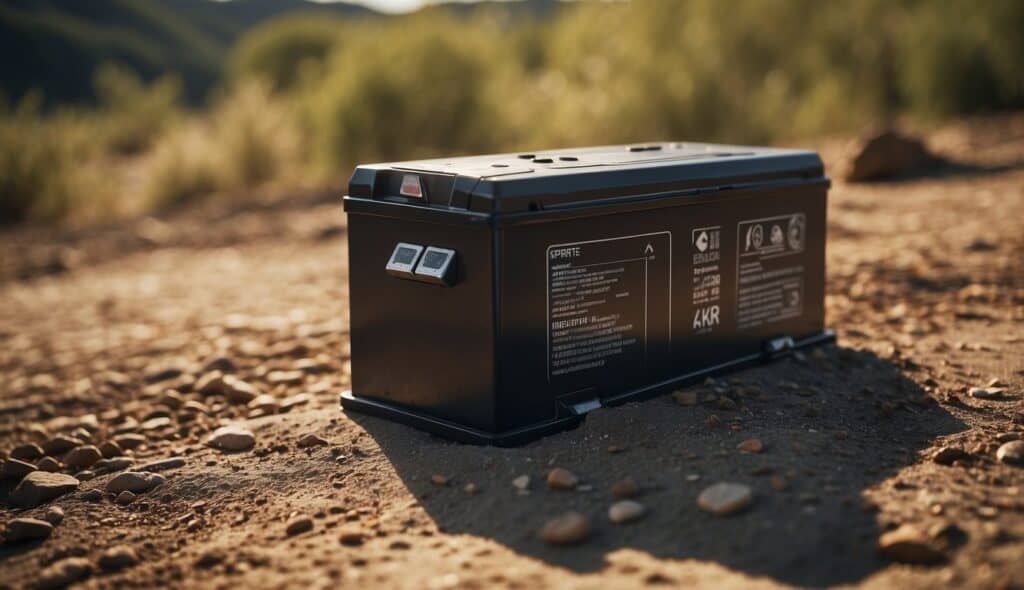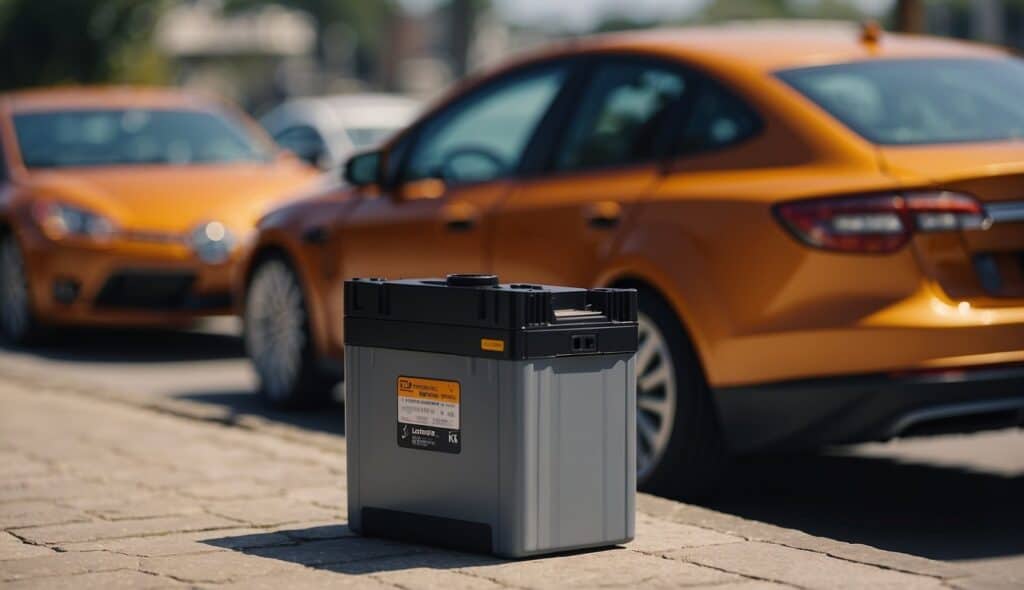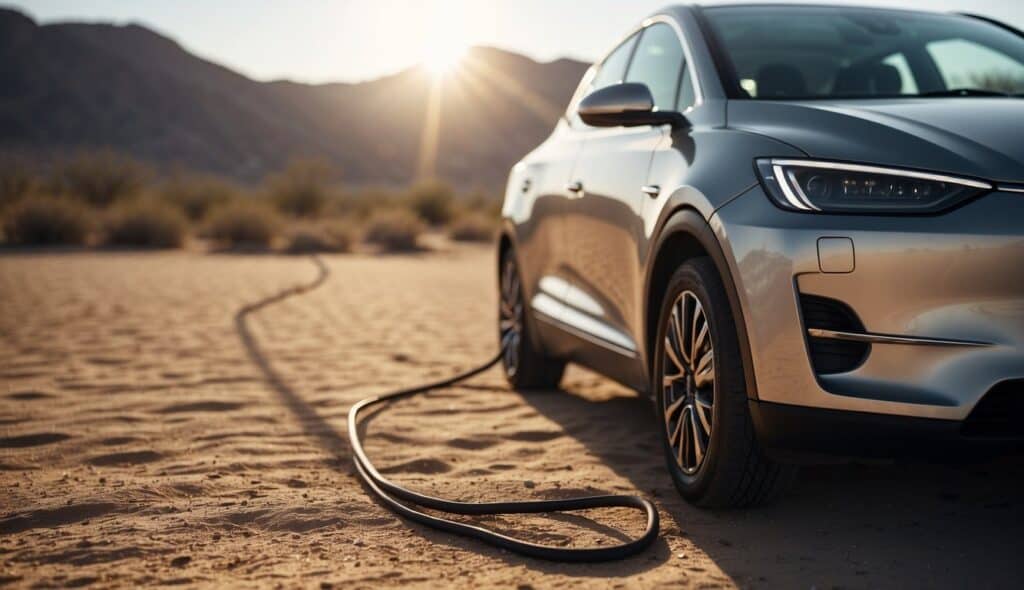Electric vehicles (EVs) are becoming a popular choice for eco-conscious drivers. However, drivers in hot climates often have concerns about how the heat affects their vehicle’s battery life.
In sweltering temperatures, electric cars can lose up to 31% of their advertised range, making it essential for drivers to understand how to manage their vehicle’s performance in such conditions.
This decrease in range occurs because the battery works harder to keep the vehicle cool, which in turn consumes more energy.
Different electric cars react uniquely to extreme heat. For example, the Tesla Model 3 has advanced cooling systems that help maintain battery life even in hot environments.
Despite the challenges, proper care and knowledge can manage and even prolong an EV’s battery life.
Simple actions like parking in shaded areas, avoiding charging during the hottest parts of the day, and regularly monitoring battery health can make a significant difference.
Driving range is not the only concern for electric car owners in hot climates.
Extreme heat can also lead to faster battery aging if not properly managed.
To prevent this, drivers should be mindful of their charging habits and consider using slower charging options when temperatures are high.
By following these practices, electric vehicle owners can enjoy their eco-friendly ride without excessive worry about battery degradation.
Impact of Temperature on Battery Life
High temperatures can significantly affect electric car battery life through chemical reactions and increased heat. Both hot and cold weather conditions uniquely impact battery performance and longevity.

Chemical Reactions and Heat
Electric car batteries experience increased stress in hot weather. The heat accelerates chemical reactions inside the battery, leading to faster battery degradation. As a battery degrades, its capacity to hold charge reduces.
When temperatures rise above 80°F, the battery’s performance starts to suffer. According to a Consumer Reports article, sustained exposure to temperatures above 167°F can quickly reduce battery life.
Extreme heat can also cause the battery to overheat. When this happens, the car’s cooling system works harder, which reduces range. Excessive heat can damage battery components, leading to potential safety hazards.
Comparing Hot and Cold Weather Effects
Cold weather impacts battery life differently than hot weather.
In freezing temperatures, the battery’s chemical reactions slow down, temporarily reducing battery capacity. Drivers may notice a reduced range in temperatures below 60°F.
Hot weather, on the other hand, leads to faster and more permanent battery degradation. Continuous exposure to high temperatures can result in a loss of up to 31% of the battery’s range.
Both hot and cold climates present challenges to battery life. Batteries struggle temporarily in cold weather, but in hot weather, the effects can be long-lasting and severe.
Proper battery management and cooling systems prevent damage and maintain optimal performance.
Check out Does an Electric Car Lose Charge When Parked?
Understanding EV Batteries
Electric vehicle (EV) batteries are complex systems designed to store and deliver electricity efficiently. Key factors include their chemistry, management systems, and how their capacity and efficiency are maintained.
Lithium-Ion Battery Fundamentals
Lithium-ion batteries are the most common type used in EVs. They offer a high energy density, meaning they can store much energy for their size. This makes them ideal for electric vehicles, which need lightweight batteries with substantial power.
Battery chemistry in lithium-ion cells involves lithium ions moving between the anode and cathode during discharge and recharge. This process allows for repeated use without significant loss of capacity.
However, these batteries perform best within a specific temperature range, ideally between 68 and 86°F or 20-30°C. Higher temperatures can accelerate the degradation of battery components, affecting longevity.
Be mindful that extreme heat can reduce the battery’s lifespan, leading to potential costly replacements. Regular monitoring and proper usage can mitigate these effects.
Battery Management Systems
A Battery Management System (BMS) is crucial for maintaining an EV battery’s health. It monitors and manages the battery’s performance, ensuring cells remain balanced and preventing overcharging or deep discharging, which can harm the battery.
Active thermal management is a part of the BMS that helps keep the battery within an optimal temperature range.
This system may include liquid cooling or air cooling techniques to prevent overheating, especially in hot climates.
By keeping the battery cool, the BMS reduces the risk of thermal degradation and enhances overall performance and longevity.
Regular software updates to the BMS can help improve battery efficiency and reliability by ensuring the latest management strategies are in place.
Capacity and Efficiency
Capacity refers to the amount of energy a battery can store, typically measured in kilowatt-hours (kWh).
Over time, an EV battery’s capacity can diminish due to various factors, including high temperatures and frequent charging cycles.
Efficiency is about how well the battery converts stored energy into usable power for the vehicle.
High efficiency means less energy is wasted and more is used to drive the vehicle.
EV batteries are designed to be highly efficient, but their efficiency can be affected by temperature, age, and usage patterns.
In hot climates, proper charging habits and active thermal management can help preserve capacity and efficiency.
Avoiding frequent fast charging and keeping the vehicle parked in shaded areas can also mitigate temperature-related degradation.
Check out Can You Charge an Electric Car with a Generator?
Electric Car Performance in Hot Climates
Hot climates can significantly affect electric car performance. High temperatures can impact both the operating range and the battery’s overall efficiency.
Effective thermal management systems are crucial to maintaining battery health and preventing overheating in extreme heat conditions.

Operating Range and Efficiency
Electric car batteries tend to degrade faster in hot climates. High temperatures can reduce the battery’s capacity and lifespan, directly impacting the vehicle’s operating range.
For instance, EV batteries degrade faster in hot weather, affecting both short-term and long-term performance.
Parking in shaded areas or garages, especially during peak sun hours, can help mitigate some of these issues.
EV owners should also know that driving habits can further influence performance in hot conditions.
Moderate acceleration and speed are recommended to avoid additional strain on the battery.
Reducing the use of air conditioning, though challenging in extreme heat, can also help maintain efficiency.
Simple practices can extend the battery’s life and preserve its range.
Thermal Management Systems
Thermal management systems are essential for protecting electric car batteries in hot climates. These systems help regulate the battery’s temperature, ensuring it operates within the optimal range of 68 to 86°F (20 to 30°C).
This is particularly important for lithium-ion batteries, which perform optimally within this temperature range.
These systems often include liquid cooling, which helps dissipate heat more effectively than air cooling.
Advanced EVs also have multiple sensors and cooling circuits to ensure even temperature distribution.
By managing battery temperature, these systems prevent overheating, which could otherwise lead to faster degradation and reduced battery life.
Check out How to Save Battery on Electric Car While Driving?
Best Practices for Battery Longevity
Owners can follow specific charging habits to protect electric car batteries in hot climates, maintain optimal temperatures, and adopt effective parking and storage strategies. These practices help extend battery life and ensure the car runs smoothly.
Charging Habits and Techniques
Using appropriate charging habits is vital for extending battery life.
Avoid charging to 100% regularly, especially in hot weather, as it can accelerate degradation. Try to keep the battery level between 20% and 80%.
Fast charging generates extra heat, which can be harmful.
Opt for Level 2 chargers instead of fast chargers for routine charging whenever possible. If you must use fast charging, limit its use to urgent situations only.
Charge at night or early in the morning when temperatures are cooler.
Hot weather increases the battery’s internal temperature; cooler ambient conditions can help keep it in a safer range.
Maintaining Optimal Temperature
Keeping the battery at an ideal temperature is crucial.
The ideal range for lithium-ion batteries is between 26-35°C (78-95°F). Temperatures above 35°C (95°F) can lead to faster degradation and reduced lifespan.
Using climate control features while driving can help maintain the battery’s temperature.
Precondition the cabin and battery while the car is still plugged in. This ensures the battery remains cool and reduces its strain during use.
Consider parking in shaded areas or garages to reduce direct heat exposure. If possible, use sunshades to keep the cabin and the battery cooler.
Parking and Storage Strategies
Where and how an EV is parked significantly affects battery longevity.
Always park in shaded or indoor areas to avoid excessive heat exposure.
For long-term storage, keep the battery charge level at around 50%. High or low charge levels for extended periods can be harmful.
Avoid leaving the car unplugged for long periods; plug it in with a timer to maintain the charge without overcharging.
A car cover can also help minimize direct sunlight exposure, keeping the cabin and the battery cooler.
Check out Do Hotels Charge for Electric Car Charging?
Design and Technology Advancements
Recent advances in the design and technology of electric vehicles significantly enhance battery life and efficiency, especially in hot climates. This includes new design optimizations, improved battery packs, and promising future technologies.

EV Design Optimization
Automakers such as Tesla, Ford with the Mustang Mach-E, and Mercedes-Benz are focusing on design features that optimize temperature control.
Improved aerodynamics and cooling systems help prevent batteries from overheating.
One key development is the incorporation of liquid cooling systems. These systems circulate coolant around the battery pack to maintain optimal temperatures, significantly reducing thermal stress.
Additionally, improved insulation materials help maintain consistent battery temperatures regardless of external conditions.
In terms of battery management, sophisticated software algorithms now play a crucial role.
These algorithms continuously monitor and adjust the battery’s environment to extend its lifespan.
Also, electric vehicles now often feature heat-resistant materials in their design, enhancing durability and performance in hotter climates.
Battery Pack Innovations
Battery pack technology has seen numerous innovations.
Tesla’s new 4680 cells are a significant leap, promising increased efficiency and better performance under high temperatures.
These cells feature a new tabless design that reduces internal resistance, leading to lower heat generation.
In addition, Ford’s Mustang Mach-E utilizes advanced battery cooling techniques.
This includes flexible thermal management systems that dynamically adjust cooling based on driving conditions.
Audi and Mercedes-Benz have also adopted active thermal management systems.
These systems use liquid cooling and strategic airflow paths to manage battery temperature, ensuring longevity and consistent performance.
Another innovation is the development of solid-state batteries. These batteries promise better heat tolerance and longer life spans, likely making them ideal for various climates.
The Future of Battery Technology
The future holds promising advances for electric vehicle batteries, particularly in hot climates.
Consumer Reports indicates that ongoing research into solid-state batteries could revolutionize the industry. These batteries are expected to have significantly higher energy densities and better thermal stability.
Automakers are also exploring second-life applications for EV batteries.
These applications repurpose used batteries for energy storage, extending their usable life and providing an eco-friendly solution to battery disposal.
Advanced battery recycling techniques are also being developed, with the aim of recovering valuable materials and minimizing waste.
Furthermore, emerging nanotechnology solutions are under investigation.
These include nano-coatings and materials that can significantly improve battery efficiency and heat resistance.
With these advancements, the future of battery technology looks bright, paving the way for more durable and reliable electric vehicles.
Check out Can You Charge an Electric Car at Home with Normal Plug?
The Influence of Charging Practices
Charging practices significantly impact electric car battery life in hot climates.
Fast charging and regenerative braking are crucial in maintaining battery health and efficiency.
The Role of Fast-Charging
Fast charging can be convenient but may affect the battery over time.
High temperatures can amplify the effects of fast charging on a battery. Repeated fast charging in hot climates can lead to accelerated battery degradation.
According to EV Chargepedia, charging in extreme heat regularly can shorten the battery’s overall lifespan.
When using fast charging, keeping the car in a shaded or cooler environment is essential to minimize heat buildup.
The battery management system will work harder in hot conditions, increasing the battery’s wear. Charging at cooler times, such as early morning or late evening, can help mitigate these effects.
Regenerative Braking Benefits
Regenerative braking can positively affect battery life, especially in hot climates.
This system recaptures energy that would otherwise be lost during braking and feeds it back into the battery. It reduces the need for frequent plug-in charging, which is beneficial in high temperatures.
This system means fewer full-charge cycles, which can help prolong battery life.
Regenerative braking is a form of charging that generates less heat than plug-in methods. In cities with heavy traffic, it can significantly improve an electric car’s efficiency and reduce the strain on the battery.
While regenerative braking is highly beneficial, it is not a complete replacement for traditional charging methods.
It should be used as a complementary practice to optimize the battery’s performance and longevity, particularly in hot weather conditions.
Check out How to Charge an Electric Car at Home Without a Garage?
Mitigating Range Loss in Hot Weather
High temperatures can impact electric vehicle (EV) battery life and driving range. Effective strategies and adaptive driving habits can help maintain efficiency during extreme weather conditions.
Understanding and Minimizing Heat Impact
Hot weather can lead to a significant range loss in EV batteries.
The optimal temperature range for lithium-ion batteries is between 68°F to 86°F. Beyond this range, especially above 95°F, the efficiency drops, and the battery components degrade faster.
To minimize heat impact, parking in shaded areas or using a car cover can reduce sun exposure.
Pre-cooling the cabin while the vehicle is still plugged in helps conserve battery power. It is also crucial to regularly check the battery’s thermal management system to ensure it is functioning properly.
Adaptive Driving for Efficiency
Adaptive driving habits can greatly improve efficiency during hot weather.
Limiting rapid acceleration and heavy braking helps conserve energy. Using eco-friendly driving modes can optimize power usage.
Maintaining moderate speeds rather than high speeds can prevent excessive battery drain.
Additionally, planning routes ahead to avoid traffic jams and reduce idling time is beneficial.
Ensuring that tire pressures are at the recommended levels also helps maintain a more efficient driving range. Reducing the load by removing unnecessary items from the car can further enhance battery longevity.
Consumer Insights and Reports
Many electric vehicle (EV) owners have reported various experiences with their cars’ batteries in hot climates. Experts have provided valuable recommendations to help EV owners mitigate these issues.
Surveying EV Owners’ Experiences
A Consumer Reports survey found that EV owners often face reduced battery range during high temperatures.
They observed that when the temperature reaches around 80°F, the vehicles’ range tends to be longest. However, as temperatures rise beyond this point, the need for cooling the vehicle’s interior increases, reducing the overall range.
Owners of popular brands like Tesla and Nissan reported noticeable dips in performance during heatwaves.
This has led to consumer concerns about the longevity and reliability of their vehicles, which has somewhat affected EV adoption in hotter regions.
Expert Analysis and Recommendations
Experts agree that hot weather accelerates EV battery degradation.
Stephen Edelstein suggests that car owners park in shaded areas and pre-cool their interiors while still plugged in to protect their cars.
Consumer Reports also advises regular maintenance and monitoring of battery health.
They recommend using the car’s thermal management system and checking for any software updates from the manufacturer. Keeping batteries cool and managing charge levels can greatly extend battery life.
Additional Factors Influencing EV Battery Life
Various factors beyond ambient temperature impact electric vehicle (EV) battery life. Weight and tire pressure combine with external temperature fluctuations to either improve or degrade battery performance.
Weight and Tire Pressure Considerations
The weight of an electric vehicle has a significant effect on battery life.
Heavier vehicles require more energy to move, placing additional stress on the battery. This leads to quicker depletion and can reduce the battery’s overall lifespan.
Drivers need to be mindful of extra cargo and passengers to optimize performance.
In addition, tire pressure plays a crucial role.
Underinflated tires increase rolling resistance, which demands more power from the battery. This can reduce the vehicle’s driving range and efficiency.
Regularly checking and maintaining optimal tire pressure helps ensure that the vehicle runs efficiently and extends the battery life.
External Temperature Fluctuations
External temperature fluctuations also influence EV battery life.
Batteries perform best within a specific temperature range. Extreme temperatures, whether hot or cold, can increase internal battery resistance, reducing efficiency and capacity.
For instance, prolonged exposure to high temperatures accelerates the degradation of battery components, such as electrodes and electrolytes.
Managing the vehicle’s environment is important.
Parking in shaded areas or using climate control systems helps keep the battery within its optimal temperature range. This reduces stress and slows the battery’s wear and tear, thus helping preserve its long-term health and performance.
Conclusion
Electric car batteries face challenges in hot climates. High temperatures can speed up the degradation of battery components.
This can impact both short-term and long-term longevity.
Owners can take steps to mitigate these effects. Parking in shaded areas or garages helps keep the car cool.
Additionally, using sunshades can further reduce interior temperatures.
Charging during cooler times of the day, like early morning or late evening, is beneficial. This reduces strain on the battery and helps maintain its lifespan.
Air conditioning while driving can draw power from the battery but also prevent overheating.
It’s a necessary trade-off that helps protect the EV’s vital components.
Monitoring battery temperature is another important step. Modern EVs often have temperature management systems.
Keeping an eye on this can help catch potential issues early.
Regular maintenance is key. Simple checks and balances can ensure the battery remains in good health, even in hotter climates.
You may also like:

Hi, I’m Marybeth, an electric car enthusiast living in New York in the USA. As the owner of electriccartalks.com, I love sharing my knowledge on EV tips, battery maintenance, and charging solutions. As a proud Tesla owner, I blend my personal experiences with professional insights to offer valuable information to fellow EV enthusiasts. Through my articles, I aim to empower others to make informed decisions about their electric vehicles. Read more